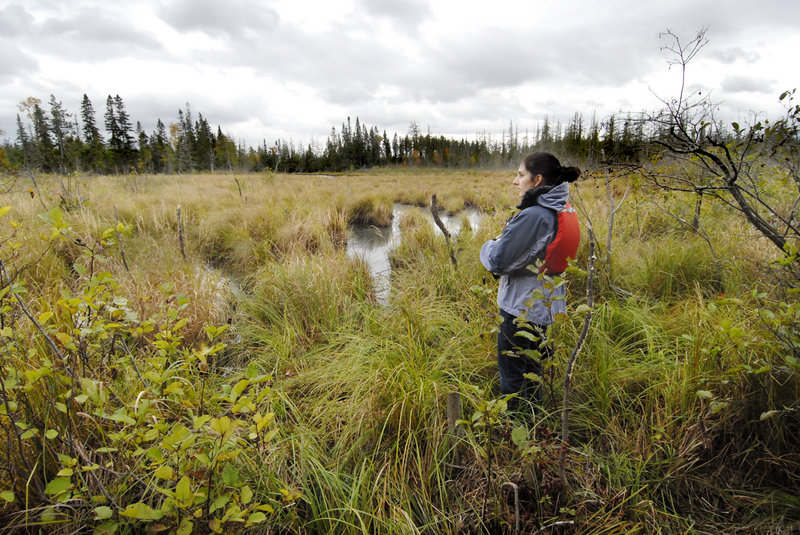This coming week, a bog with its surrounding ring of black spruce, tamarack and occasional white cedar strikes me as the perfect destination for a hike, a surprising conclusion when considering so many critters in this habitat have migrated away or lie concealed in trees, shrubs and forest debris or beneath the ground and water surface.
This absence of abundant wildlife sightings heightens the feeling of solitude, though, strangely comforting during the holiday hubbub. It feels so good to escape to a tranquil place for a short while.
The semi-frozen ground surface creates easy walking with less fear of sinking in mud over boot tops, but still, folks should be careful when stepping on dry-looking moss carpets, covering squishy black muck.
I learned the last tip at 7 years of age when stepping onto this moss and sinking to my crotch, which coated my feet and legs with icy, black goo. A walking staff to poke at wetland ground helps, but an experienced hiker can tell by eyeballing the questionable spot — most of the time anyway.
(Near each bog, I usually find a sturdy staff on the ground and leave it leaning against a tree trunk for future use there.)
In snow or half-frozen moss, hare, deer, moose and coyote leave tracks as do tiny rodents, songbirds, ruffed and spruce grouse, etc. These critters often move out of sight when humans approach, but spotting tracks pleases most hikers and, sooner or later, furtive animals cooperate.
In late spring, this fecund habitat holds so much more life, beginning with palm warblers, northern parulas and olive-sided flycatchers. As I pass places where brief meetings with these birds have occurred, memories drift through the mind.
Olive-sided flycatchers have such a fascinating call — “quick three beers,” and this drab, solitary bird enunciates this spring sound so clearly. I may walk in bogs in late May solely to hear a bird ordering a beer.
Northern parulas build a pendulum nest in hanging moss or conifer twigs that looks like a basket, an eye-catcher. It’s easier to find this nest in woodlands with lots of hanging moss — but seldom easy.
Palm warblers lack colorful plumage to help with identification, but they wag their longish tails almost constantly, one key for a distant ID.
Besides songbirds, bogs hold fascinating plants, and in June, we cannot miss two carnivorous species, round-leaved sundew and northern pitcher plants as well as sphagnum moss and leatherleaf.
Another wetland habitat intrigues me for an odd reason. In central Maine, we call it red-maple swamp, a term that once struck me as colloquial speech, but in the early 1990s, a New England nature guidebook included a section that highlighted red-maple swamps.
“I’ll be damned!” I said aloud despite no one was present to hear. Since then, I’ve noted the phrase in other guidebooks.
Like bogs, red-maple swamps offer solitude now, because many birds migrate south or north and myriad swamp creatures winter there out of sight. Yes, the silence in December woods sometimes sounds loud.
This habitat is common across Maine, and in rich, black soil — less acidic than in bogs — mature red maples and speckled alder grow above thigh-high swale grass. Pussy willows, red osier (tropical-looking member of dogwood family with showy red twigs) and skunk-cabbage patches also spring up in this wetland, so wildlife flourishes in such abundant cover.
Farmers dislike alder thickets reclaiming upland fields, but this shrub belongs to the legume family, a plant that enriches soil, so alders ensure the swamp’s successful transition to high-canopied habitat. As this wetland dries with age, it changes from shrubby habitat to red maple and maybe black ash — the latter called “basket wood.” White cedar may move in, too.
Common redpoll, gray catbird, northern waterthrush (really a warbler), veery (most faintly spotted of eastern thrushes emits a beautiful call), alder flycatcher (solitary species not always easy to spot), yellow warbler and American woodcock live in this habitat in warmer seasons.
For the record, I see woodcock more in upland alders with thick goldenrod, ideal earthworm soil that’s richer and moist but not too wet. It attracts this game bird more than red-maple swamps do.
The nocturnal star-nosed mole lives in red-maple swamps, too, a creature with 22 star-like, pink, fleshy projections, sticking out around the nostrils. House cats living by swamps prey on these moles and leave the carcasses in driveways, often in spring. That’s usually our introduction to this unique rodent with star-shaped tentacles centered on the face.
December makes it a great time to poke around bogs and swamps, so now folks can easily explore two habitats that they might have missed in life. That’s the joy for amateur naturalists — the opportunity to explore places that many people skip. At first, these lands may seem strange but soon they become familiar for astute observers of the natural world.
Ken Allen of Belgrade Lakes is a writer, editor and photographer. He can be contacted at:
KAllyn800@yahoo.com
Send questions/comments to the editors.



Success. Please wait for the page to reload. If the page does not reload within 5 seconds, please refresh the page.
Enter your email and password to access comments.
Hi, to comment on stories you must . This profile is in addition to your subscription and website login.
Already have a commenting profile? .
Invalid username/password.
Please check your email to confirm and complete your registration.
Only subscribers are eligible to post comments. Please subscribe or login first for digital access. Here’s why.
Use the form below to reset your password. When you've submitted your account email, we will send an email with a reset code.